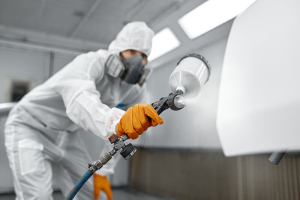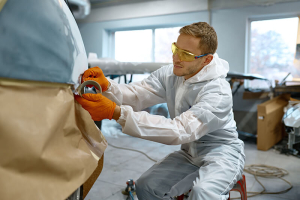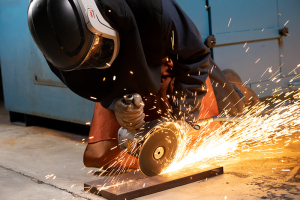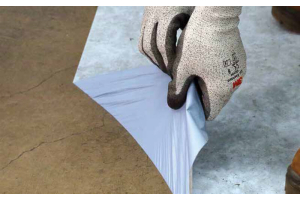Why should I wear a respirator (or any PPE) for that matter?
Employers are required by OSHA to provide proper personal protective equipment (PPE) to minimize exposure from hazards encountered in the workplace. Realistically though, there are two other very compelling reasons to actively seek out and use the equipment provided. Some environments encountered in the workplace are toxic and dangerous and using the correct PPE will get you through the work day. A respirator can keep you from getting sick or passing out from breathing paint vapors, fall protection equipment can keep you from a hard landing on the ground or in the bushes, and the correct gloves can save your skin from obvious cutting hazards. Those are all examples of acute exposure that can save you from a lost time injury. Wearing correct (PPE) keeps you from getting fatigued so you can have a life after work. But don't forget the long term benefits as well, using the correct PPE will protect you from long term illnesses also. In part one of this multi-part series I want to cover selecting a respirator since nothing can make you sicker in a hurry than not using protection or using wrong breathing protection.
Before you go to work, take the time to do it right. A medical evaluation is necessary for careers requiring a respirator. They help people with pulmonary problems select equipment that won’t compromise their health. If this is something you are doing on your own, please dear reader, be serious about your health. Contact us or visit a safety supply store with a good selection and ask for help from someone trained to help with the details. There are many brands (3M, MSA, North) and styles to find respiratory protection that will protect you while being as comfortable as possible.
In choosing the right respirator, first you will need to choose the correct type. N95 dust masks (correctly called filtering facepiece respirators) are a great choice for most dusty work because they are lightweight, comfortable, and inexpensive. But if you are chipping old paint or into some kind of toxic junk you will need to step up to a P100. The numbers stand for the percentage of efficiency, so the N95 filters out 95% of the dust and the P100 gets all of it down to .3 micron sized particles (99.9%). An exhalation valve is a huge improvement on the design because it allows spent air and moisture to get out easier so you get to breathe much fresher air. They cost a little more and are worth every extra penny if you are going to wear the mask for longer than 20 minutes or are working up a sweat.
If your work involves some kind of evaporating solvent or particle like painting, fiberglassing, degreasing, or solvent cleaning something, then an organic vapor respirator is your choice. The cartridges on these are actually charcoal made from coconut husks; very porous, and the solvents are trapped by a process called ‘adsorption’ meaning the solvents stick in the carbon bed and can’t get out. They don’t last forever so if you don’t know how old your cartridges are it’s best to start with a fresh set. And please remember to have some fans or work outside, these types of respirators don’t supply oxygen so if the workplace is small and confined you’ll need to keep fresh air coming in somehow. Add particulate pre-filters if there is dust or paint overspray to prevent the airborne junk from plugging the organic cartridges.
So you now have chosen the correct style respirator for the work ahead, but don’t buy one unless you know it fits. Manufacturers usually have three sizes based on the distance from the bridge of your nose to the underside of your chin. Ask to try some different ones on or better yet get fit tested on your favorite choice. After putting the respirator on (donning) a quick way to test the fit is to cover the exhaust port with your palm and blow puffs of air listening for leaking air. No leak means a good fit and your respirator fits. If it does leak, try tightening or maybe even loosening the straps or move the facepiece lower on your nose. It’s important to wear it low enough to get safety glasses onto your nose. This is probably a good time to say beards (even stubble) are a problem with respirators. Because you are pulling air through cartridges and small ports that both restrict air flow, a good seal between your face and the respirator is required. A stray hair isn’t a problem but a beard pushes the whole thing away from your skin breaking the seal and allowing all that contaminated air a nice easy passage right to your airways. Did you know there is only a two cell membrane in your lungs separating your blood from the outside? Scary! If you have a beard you want to keep and your work requires a respirator then your choices are limited to supplied air respiratory protection. I’ll discuss these options in a future section. I personally like using supplied air because it’s the closest to not wearing a respirator at all.
[youtube https://www.youtube.com/watch?v=DzIDhYGnDIM&w=560&h=315]
So you have the correct respirator for the job in a size that fits and maybe you even got a fit test. Now its time to get to work, but afterwards you will want to clean your respirator. A dust mask doesn’t need any maintenance, but a reusable respirator (cartridge style) should be wiped out or cartridges removed and washed with dish soap. When you are done using your respirator, store it in a paper or vented plastic bag with your name and today’s date on it, away from contaminants. Leaving a respirator on a bench or hanging from a nail in your home is OK, but at work it can trigger a $1000 OSHA violation so make sure you put it away.
Check in again for info on air supply respirators, safety glove selection, and more.












